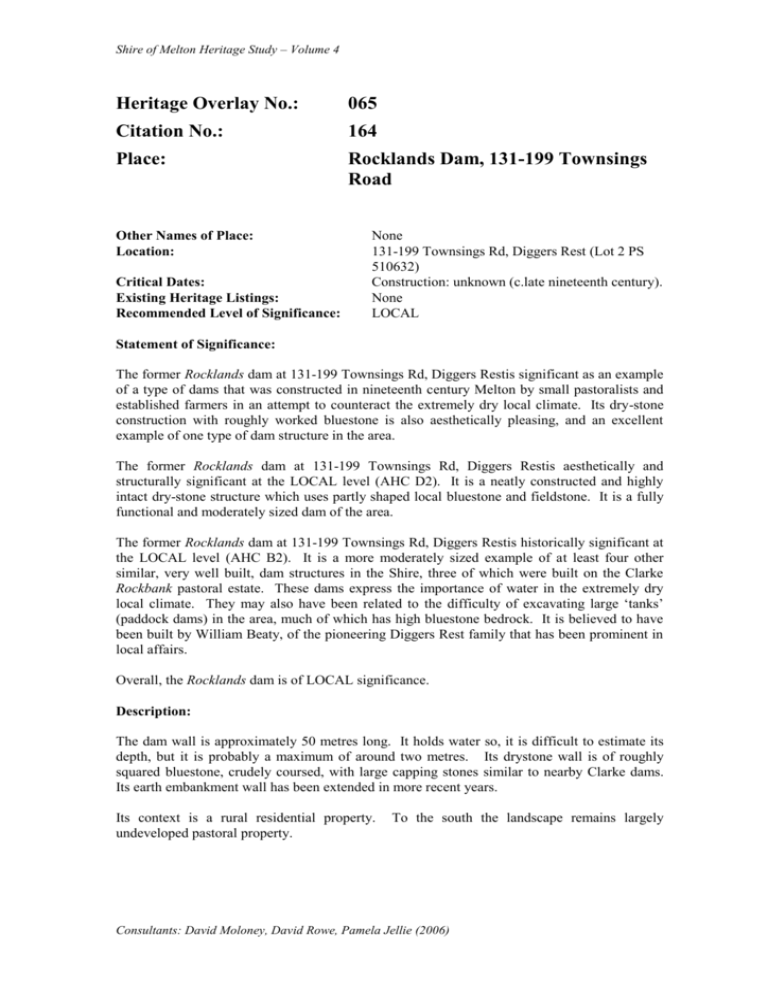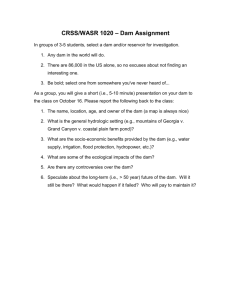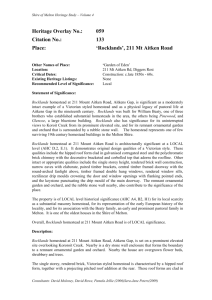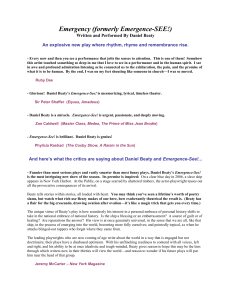Citation No.: 164 - Melton City Council
advertisement

Shire of Melton Heritage Study – Volume 4 Heritage Overlay No.: 065 Citation No.: 164 Place: Rocklands Dam, 131-199 Townsings Road Other Names of Place: Location: Critical Dates: Existing Heritage Listings: Recommended Level of Significance: None 131-199 Townsings Rd, Diggers Rest (Lot 2 PS 510632) Construction: unknown (c.late nineteenth century). None LOCAL Statement of Significance: The former Rocklands dam at 131-199 Townsings Rd, Diggers Restis significant as an example of a type of dams that was constructed in nineteenth century Melton by small pastoralists and established farmers in an attempt to counteract the extremely dry local climate. Its dry-stone construction with roughly worked bluestone is also aesthetically pleasing, and an excellent example of one type of dam structure in the area. The former Rocklands dam at 131-199 Townsings Rd, Diggers Restis aesthetically and structurally significant at the LOCAL level (AHC D2). It is a neatly constructed and highly intact dry-stone structure which uses partly shaped local bluestone and fieldstone. It is a fully functional and moderately sized dam of the area. The former Rocklands dam at 131-199 Townsings Rd, Diggers Restis historically significant at the LOCAL level (AHC B2). It is a more moderately sized example of at least four other similar, very well built, dam structures in the Shire, three of which were built on the Clarke Rockbank pastoral estate. These dams express the importance of water in the extremely dry local climate. They may also have been related to the difficulty of excavating large ‘tanks’ (paddock dams) in the area, much of which has high bluestone bedrock. It is believed to have been built by William Beaty, of the pioneering Diggers Rest family that has been prominent in local affairs. Overall, the Rocklands dam is of LOCAL significance. Description: The dam wall is approximately 50 metres long. It holds water so, it is difficult to estimate its depth, but it is probably a maximum of around two metres. Its drystone wall is of roughly squared bluestone, crudely coursed, with large capping stones similar to nearby Clarke dams. Its earth embankment wall has been extended in more recent years. Its context is a rural residential property. undeveloped pastoral property. To the south the landscape remains largely Consultants: David Moloney, David Rowe, Pamela Jellie (2006) Shire of Melton Heritage Study – Volume 4 History: John Beaty arrived in the colony from Co Tyrone, Ireland in 1848,1 and purchased a large allotment at one of the first sales of Crown Land in the district. In August 1852 he purchased the first, and largest, of numerous Crown Allotments he was soon to acquire in the Black Hill Road area. Crown Allotment 20 of 482 acres, Parish of Holden, was purchased jointly with a ‘John Beattie’, for the very good price of ₤578. Five months later, in January 1853, John Beattie sold John Beaty his half share in this allotment for ₤1446.2 Beaty had done well to establish in this early pastoral area, with Green Hills on his west, the famous early squatter and sheep breeder John Aitken to his north and east, and the notorious pastoral giant WJT (Big) Clarke to his south. By 1854 Beaty had a well-established ‘homestead’ on his allotment, situated the east bank of the West Branch of Kororoit Creek. 3 At Crown Land sales between 1854-57, Beaty capitalised on his foothold and purchased the majority of his holding - a further 1547 acres. He purchased 15 separate but contiguous parcels of land, some of which cost, in this gold-rush period, over ₤4 per acre. In total Beaty acquired some 2030 acres (c.820 hectares) in the 1850s Crown sales. Most of this land was situated on the west side of the West Branch of Kororoit Creek, formerly part of the Green Hills Station, where the new Pinewood homestation, and Glencoe, would later be built. He also purchased another four allotments in the Parish of Holden, on the east side of the West Branch of the Kororoit Creek, originally part of the Mt Aitken Station. One of the allotments, purchased 26th June 1857, was the allotment on which the dam is situated:- Crown Allotment 4, Section 19, of 103 acres 3 perches.4 Beaty also purchased two contiguous allotments, of about the same size, to the north and west of this section. This was where his son William would later establish himself and build the Rocklands homestead and dam. John Beaty senior divided his estate between his sons John junior, Andrew and William. John junior was apportioned (sold for a small sum) the property on West Branch of Kororoit Creek as far west as Blackhill Road, in 1872.5 On this land (about 716 acres by the late 1880s) the bluestone homestead Pinewood was built by John junior in 1875.6 In 1879 John senior and his wife Eliza transferred some 318 acres of land on the east side of the West Branch of Kororoit Creek (which had increased to some 739 acres in the late 1880s), to William (‘of Kororoit Creek, farmer’). This is where Rocklands homestead is built.7 The next day John senior transferred to Andrew Beaty the property (some 803 acres by the late 1880s) on which the Glencoe homestead is built.8 John senior retained some 600 acres in his own name,9 which was probably the site of his original homestead.10 1 Starr, op cit, p.29. There is some suggestion that the Beaty may have been in possession of the property from 1848 (John Beaty, personal conversation, 8/5/2002) 2 PROV Torrens Application file: VPRS 460/P0 (39493). 3 Lands Victoria, Put-Away Plan Y27 (1854) 4 Parish Plan, Parish of Holden 5 PROV Torrens Application file: VPRS 460/P0 (39493), Conveyance John Beaty to John Beaty the Younger,12/2/1872. 6 Shire of Melton Ratebooks, 1887-1888. 7 PROV Torrens Application file: VPRS 460/P0, Unit 817 (48954), Conveyance John Beaty to William Beaty,19/9/1879; also Shire of Melton Ratebooks, 1887-1888. 8 PROV Torrens Application file: VPRS 460/P0 (37508), Conveyance John Beaty to Andrew Beaty, 20/9/1879; also Shire of Melton Ratebooks, 1887-1888. 9 Shire of Melton Ratebooks, 1887-1888. 10 John Beaty, personal conversation, 8/5/2002. Consultants: David Moloney, David Rowe, Pamela Jellie (2006) Shire of Melton Heritage Study – Volume 4 William and his brother Andrew went back to Ireland where they both married before returning home.11 It is possible that the construction of the Rocklands homestead was associated with William’s marriage. Family sources advise that William was the eldest, considerably older than John junior, who did not marry until he was in his 40s. So it is thought likely that Rocklands was built quite a bit earlier than the house John junior built in 1875 (Pinewood), perhaps as early as the late 1850s.12 An early date for Rocklands is supported by the fact that William Beaty was already independently established on the property in 1864, as is evidenced by his purchase, from Hugh Glass and George Holmes at a mortgage auction, of two adjacent allotments of some 475 acres (originally owned by O.Connor and P.Phelan).13 All that can be definitely known from the Shire ratebooks is that the house was constructed by 1888, when houses were first listed in the ratebooks.14 Beaty was shown still in ownership of the property, now expanded by the Connor and Phelan allotments, in 1892.15 William Beaty had a son William James, and six daughters: Jane, Adie, Alice, Elizabeth, Violet and Sarah. John Beaty senior had died in November 1899, leaving his son William ‘Ryans Paddock’, some 350 acres to the west of Black Hill Road. Ratebooks continue to rate ‘William Beaty’ for the 775 acres plus house until at least 1920. 16 In 1920 his daughters had sold their 374 acres to HG Townsing of New Gisborne for ₤4493. These were probably the original Connor and Phelan allotments, on the opposite side of the road to the house and dam. In 1929 William’s widow Eliza sold Rocklands to Henry George Townsing, (still ‘of Gisborne’) for ₤4310.17 Townsing moved in to the house and the road came to be named after him. While the house Rocklands is shown on a 1916 map, the dam is not. This does not mean that the dam was not there in 1916, as there are some errors in these maps, and occasional grey areas when some sites are mapped in one year but not another. It is shown on the 1938 Map. Presuming that the dam was not built by William Beaty, it would have had to have been built in the few years (1929-1938) between Townsing purchasing the property and the dam appearing on a Map. It is possibly but highly unlikely that a new dam built in the early 1930s would have been built of bluestone. The Beaty family believe that William Beaty built the dam, date unknown, but possibly prior to 1875.18 The fact that bluestone had been used to at least some extent for all of the brothers’ houses (Rocklands, Glencoe, and Pinewood) homesteads, and had been readily obtained from a quarry behind Glencoe, adds to the near certainty of it having been built by William Beaty.19 The dam was built at the southern end of the William Beaty land, presumably to take full advantage of the southerly gradient of the property. It was built almost at the boundary of his southern neighbour WJT Clarke’s Rockbank estate. Only a little further south, on the same gully, WJT Clarke built one of his large drystone wall dams. (Site No.082) 11 ibid John Beaty, personal conversation, 25/10/2004. Further family genealogical information on marriage dates etc might provide clues that would help to date the building. 13 Torrens Application 48954, PROV VPRS 460 (Unit 817) 14 Shire of Melton Ratebooks, 1872-73, 1882-83, 1887-88. 15 Shire Map Series, 1892: Parish of Holden. 16 Shire of Melton Ratebooks, 1913-14, 1919-20 17 Torrens Application 48954, PROV VPRS 460 (Unit 817) 18 John Beaty, personal conversation, 8/5/2002 19 John Beaty, personal conversation, 8/5/2002 12 Consultants: David Moloney, David Rowe, Pamela Jellie (2006) Shire of Melton Heritage Study – Volume 4 Contextual evidence of pastoral water supply history also supports an early date of construction for the dam. Pastoralists’ first ‘permanent improvements’ after obtaining security of tenure were erecting fences and sinking waterholes.20 But the excavation of large ‘tanks’ (shallow dams in paddocks, not on watercourses) only began to come into general use in the 1870s, 21 so it is very possible that the dam pre-dated this later solution. In any case the excavation of ‘tanks’ in the plains district would have been particularly difficult, if not impossible in many places, due to the very shallow basalt bedrock of much of the area. Unable to dig ‘tanks’ in the earth, the Melton solution seems to have been to construct quarried bluestone dam walls across the shallow gullies of the district. Three similar dams are known to have been built by Clarke in the Shire, and another smaller one by another small farmer, Murphy. It is most likely that idea for and the construction of the dams evolved over years. While it is possible that they could date to 1860s, when the the shearing shed was built, or even earlier, it is also possible they were a part of the capital improvements that are known to have occurred in the late 1870s – early 1880s, when Sir WJ Clarke assumed management of the property. The Beaty family have lived in the area since at least 1852 when John first purchased Crown land, and have been prominent in the life of the community. One member – another John Beaty – was for 36 years a Melton Councillor, and served six terms as Shire President. ‘Beaty’s Bush Paddock’ was for many years the site of annual ‘Bird Day’ excursions for scholars at the nearby Toolern Vale State School.22 Thematic Context / Comparative Analysis: Melton Historical Themes: ‘Water’, ‘Pastoralism’ Known comparable examples: This is one of a number of ‘drystone’ dams in the Shire. Most were large, well professionally constructed dams on WJT and Sir WJ Clarke’s Rockbank pastoral station. One of these, on the Coimadai – Diggers Rest Road (Site No.082) is situated only a short distance down the same gully as the Beaty dam. The others are the Rockbank Headstation Dam (Site No.443); the Plumpton Dam (Site No.151); and the Holden Road Dam (Site No.110). The most comparable dam would appear to be near the railway line at Diggers Rest (Site 077). This is a similarly low dam, well constructed of roughly shaped bluestone, and of similar scale (although a little smaller). The growth of reeds in its dam now makes it difficult to see and fully appreciate this dam, which was probably built by the Diggers Rest pioneer Murphy. There is also a dry stone wall dam substantially constructed of fieldstone, with several walls on several sides, and across part of the dam, at 847-1071 Blackhill Road Diggers Rest. This dam would have been built by the Beaty family. 20 Peel, op cit, pp.108-109; also Brown, PL (ed), The Narrative of George Russell of Golf Hill (OUP, London, 1935), pp.373-374 21 Hughes, Trueman, Ludlow, ‘Wells and Underground Tanks’, prepared for the Heritage Council of NSW (nd), pp.25-28; also Albrecht, CE, Measurments and Drawings of Tanks and Dams, Melbourne, Arnell & Jackson, [1885?] 22 Toolern Vale State School Centenary History 1869-1969 (Toolern Vale State School Centenary Celebrations Committee, 1969), Consultants: David Moloney, David Rowe, Pamela Jellie (2006) Shire of Melton Heritage Study – Volume 4 There has been no thematic study of pastoral dams in Victoria, and there are no other similar pastoral dams have been identified in the Victorian Heritage Register, or the National Trust register. The lake at Rupertswood, Sunbury has bluestone edging, but this is an ornamental or landscape feature. Condition: Good Integrity: Substantially Intact Recommendations: Recommended for inclusion in the Melton Planning Scheme Heritage Overlay. Recommended Heritage Overlay Schedule Controls: External Paint Controls: Internal Alteration Controls: Tree Controls: Outbuildings and/or Fences: No No No No Consultants: David Moloney, David Rowe, Pamela Jellie (2006)











